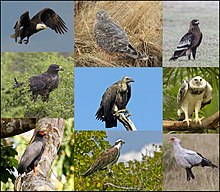อันดับเหยี่ยว
อันดับเหยี่ยว[3] (ชื่อวิทยาศาสตร์: Accipitriformes) เป็นอันดับของนกที่ประกอบด้วยนกล่าเหยื่อเวลากลางวันส่วนมาก เช่น เหยี่ยว, อินทรี และแร้ง
| อันดับเหยี่ยว ช่วงเวลาที่มีชีวิตอยู่: สมัยอีโอซีน-ปัจจุบัน, 50–0Ma [1] | |
|---|---|

| |
| ตามเข็มนาฬิกาจากบนซ้าย: อินทรีหัวขาว (Haliaeetus leucocephalus), cinereous harrier (Circus cinereus), นกอินทรีปีกลาย (Clanga clanga), นกอินทรีฮาร์ปี (Harpia harpyja), นกเลขานุการ (Sagittarius serpentarius), เหยี่ยวออสเปร (Pandion haliaetus), slate-colored hawk (Buteogallus schistaceus), เหยี่ยวกาลาปาโกส (Buteo galapagoensis), แร้งเทาหลังขาว (Gyps africanus) (กลาง) | |
| การจำแนกชั้นทางวิทยาศาสตร์ | |
| โดเมน: | ยูแคริโอต |
| อาณาจักร: | สัตว์ |
| ไฟลัม: | สัตว์มีแกนสันหลัง |
| ชั้น: | สัตว์ปีก |
| เคลด: | Accipitrimorphae |
| อันดับ: | เหยี่ยว Vieillot, 1816 |
| วงศ์ | |

| |
| แผนที่ความหลากหลายของอันดับเหยี่ยว (258 ชนิด) ความเข้มของสี (จากอ่อนไปเข้ม) บ่งบอกถึงความสมบูรณ์ของสายพันธุ์[2] | |
ในอดีตจะรวมเหยี่ยวในอันดับ Falconiformes แต่ผู้แต่งบางคนแยกมาไว้ในอันดับ Accipitriformes[4][5][6][7] การศึกษาดีเอ็นเอที่ตีพิมพ์ใน ค.ศ. 2008 แสดงว่า เหยี่ยวปีกแหลม]ไม่ได้เป็นญาติใกล้ชิดกับนกในอันดับ Accipitriformes แต่ใกล้ชิดกับนกแก้วและนกเกาะคอน[8] ตั้งแต่การแบ่งแยก (แต่ก็ไม่ได้วางเหยี่ยวถัดจากนกแก้วหรือนกเกาะคอน) ได้รับการยอมรับโดยคณะกรรมการการการจัดแบ่งประเภทอเมริกาใต้แห่งสมาคมนักปักษีวิทยาแห่งอเมริกา (American Ornithologists' Union) (SACC),[9][10][11] คณะกรรมการการจัดแบ่งประเภทอเมริกาเหนือ (NACC),[12][13] และ การประชุมปักษีนานาชาติ (IOC)[14][15] สหภาพปักษีวิทยาบริติชให้การยอมรับอันดับ Accipitriformes[16] และจัดการย้าย Falconiformes[17] บนพื้นฐานของดีเอ็นเอและการจัดประเภทของ NACC และ IOC ได้จัดแร้งโลกใหม่ใน Accipitriformes[8][12] ในขณะที่ SACC จัดให้แร้งโลกใหม่อยู่ในอันดับที่มีชื่อว่า Cathartiformes
อนุกรมวิธาน
แก้ปัจจุบัน Accipitriformes มี 262 ชนิดและ 75 สกุลใน 4 วงศ์ขยาย และอาจมีวงศ์ที่สูญพันธุ์ 1 วงศ์ ถือเป็นอันดับแรปเตอร์ที่หากินตอนกลางวันที่มีจำนวนมากที่สุด การวิเคราะห์ลำดับดีเอ็นเอเสนอแนะว่า อันดับ Accipitriformes เริ่มแบ่งอยกประมาณช่วงระหว่างสมัยอีโอซีน/โอลิโกซีน (ประมาณ 34 ล้านปีก่อน) การแยกกลุ่มก่อให้เกิดสกุล Elanus และ Gampsonyx จากสกุล Accipitriformes อื่น ๆ[18]
- Accipitridae (เหยี่ยวหน้าเทา, อินทรี, เหยี่ยวรุ้ง, เหยี่ยวนกเขา, เหยี่ยวไคต์, แร้งโลกเก่า)
- Cathartidae (แร้งโลกใหม่)
- Pandionidae (เหยี่ยวออสเปร)
- Sagittariidae (นกเลขานุการ)
| Neoaves |
| ||||||||||||
ตารางวิวัฒนาการชาติพันธุ์อิงจาก Nagy, J. & Tökölyi, J. (2014).[19]
อ้างอิง
แก้- ↑ Mayr G, Smith T. A diverse bird assemblage from the Ypresian of Belgium furthers knowledge of early Eocene avifaunas of the North Sea Basin. N Jb Geol Paläontol, Abh. 2019;291:253–281. doi: 10.1127/njgpa/2019/0801.
- ↑ Nagy, Jenő (2020). "Biologia Futura: rapid diversification and behavioural adaptation of birds in response to Oligocene–Miocene climatic conditions" (PDF). Biologia Futura. 71 (1–2): 109–121. doi:10.1007/s42977-020-00013-9. PMID 34554530.
- ↑ อันดับเหยี่ยว ดัชนีสิ่งมีชีวิต กลุ่มอนุรักษ์ความหลากหลายทางชีวภาพและสิ่งแวดล้อม
- ↑ Voous 1973.
- ↑ Cramp 1980, pp. 3, 277.
- ↑ Ferguson-Lees & Christie 2001, p. 69.
- ↑ Christidis & Boles 2008, pp. 50–51.
- ↑ 8.0 8.1 Hackett et al. 2008.
- ↑ Remsen et al.
- ↑ Remsen 2008.
- ↑ Nores, Barker & Remsen 2011.
- ↑ 12.0 12.1 Chesser et al. 2010.
- ↑ Chesser et al. 2012.
- ↑ Gill & Donsker.
- ↑ Gill & Donsker 2014.
- ↑ Dudley et al. 2006.
- ↑ Sangster et al. 2013.
- ↑ Mindell, David; Fuchs, Jerome; Johnson, Jeff (2018). "Phylogeny, Taxonomy, and Geographic Diversity of Diurnal Raptors: Falconiformes, Accipitriformes, and Cathartiformes.". ใน Sarasola, José Hernán; Grande, Juan Manuel; Negro, Juan José (บ.ก.). Birds of Prey Biology and conservation in the XXI century. Springer. pp. 3–32. doi:10.1007/978-3-319-73745-4. ISBN 978-3-319-73744-7. S2CID 49622660.
- ↑ Nagy, Jenő; Tökölyi, Jácint (2014). "Phylogeny, Historical Biogeography and the Evolution of Migration in Accipitrid Birds of Prey (Aves: Accipitriformes)". Ornis Hungarica. 22: 15–35. doi:10.2478/orhu-2014-0008. S2CID 46321534.
บรรณานุกรม
แก้- Chesser, R. T.; Banks, R. C.; Barker, F. K.; Cicero, C.; Dunn, J. L.; Kratter, A. W.; Lovette, I. J.; Rasmussen, P. C.; Remsen, J. V. Jr.; Rising, J. D.; Stotz, D. F.; Winker, K. (2010). "Fifty-First Supplement to the American Ornithologists' Union Check-list of North American Birds" (PDF). The Auk. 127 (3): 726–744. doi:10.1525/auk.2010.127.3.726. S2CID 86363169.
- Chesser, R. Terry; Banks, Richard C.; Barker, F. Keith; Cicero, Carla; Dunn, Jon L.; Kratter, Andrew W.; Lovette, Irby J.; Rasmussen, Pamela C.; Remsen, J. V.; Rising, James D.; Stotz, Douglas F.; Winker, Kevin (2012). "Fifty-Third Supplement to the American Ornithologists' Union Check-List of North American Birds". The Auk. 129 (3): 573–588. doi:10.1525/auk.2012.129.3.573. S2CID 198159113. Full text via AOU, COPO, BioOne.
- Christidis, Les; Boles, Walter E. (2008). Systematics and Taxonomy of Australian Birds. CSIRO Publishing. ISBN 978-0-643-06511-6. สืบค้นเมื่อ 2010-01-14. Includes a review of recent literature on the controversy.
- Cramp, Stanley (1980). Handbook of the Birds of Europe, the Middle East and North Africa: The Birds of the Western Palearctic – Hawks to Bustards. Oxford University Press. pp. 3, 277. ISBN 978-0-19-857505-4.
- Dudley, S. P.; Gee, M.; Kehoe, C.; Melling, T. M. M. (2006). "The British List: A Checklist of Birds of Britain (7th edition)" (PDF). Ibis. 148 (3): 526. doi:10.1111/j.1474-919X.2006.00603.x.
- Ferguson-Lees, James; Christie, David A. (2001). Raptors of the World. Illustrated by Kim Franklin, David Mead, and Philip Burton. Houghton Mifflin. ISBN 978-0-618-12762-7. สืบค้นเมื่อ 2011-05-26.
- Gill, Frank; Donsker, D. "IOC World Bird List (version 2.4)". Worldbirdnames.org. คลังข้อมูลเก่าเก็บจากแหล่งเดิมเมื่อ 24 March 2010. สืบค้นเมื่อ 2010-03-12.
- Hackett, Shannon J.; Kimball, Rebecca T.; Reddy, Sushma; Bowie, Rauri C. K.; Braun, Edward L.; Braun, Michael J.; Chojnowski, Jena L.; Cox, W. Andrew; Han, Kin-Lan; Harshman, John; Huddleston, Christopher J.; Marks, Ben D.; Miglia, Kathleen J.; Moore, William S.; Sheldon, Frederick H.; Steadman, David W.; Witt, Christopher C.; Yuri, Tamaki (2008). "A phylogenomic study of birds reveals their evolutionary history". Science. 320 (5884): 1763–68. Bibcode:2008Sci...320.1763H. doi:10.1126/science.1157704. PMID 18583609. S2CID 6472805.
- Gill, Frank; Donsker, D. (2014). "Updates". IOC World Bird List. เก็บจากแหล่งเดิมเมื่อ 2014-09-24. สืบค้นเมื่อ 2014-09-30. Falconiformes was resequenced in version 4.1 (Jan 7, 2014)
- Nores, Manuel; Barker, Keith; Remsen, Van (July 2011). "Proposal (491) to South American Classification Committee: Change linear sequence of orders for Falconiformes, Psittaciformes, and Cariamiformes". เก็บจากแหล่งเดิมเมื่อ 2012-04-01. สืบค้นเมื่อ 30 September 2014.
- Remsen, Van (November 2008). "Proposal (383) to South American Classification Committee: Separate Accipitriformes from Falconiformes". คลังข้อมูลเก่าเก็บจากแหล่งเดิมเมื่อ 2010-06-28. สืบค้นเมื่อ 30 September 2014.
- Remsen, J. V. Jr.; Cadena, C. D.; Jaramillo, A.; Nores, M.; Pacheco, J. F.; Robbins, M. B.; Schulenberg, T. S.; Stiles, F. G.; Stotz, D. F.; Zimmer, K. J. "A classification of the bird species of South America (section "ACCIPITRIDAE (HAWKS) 3" note 1)". Version 11 December 2008. American Ornithologists' Union. คลังข้อมูลเก่าเก็บจากแหล่งเดิมเมื่อ 12 April 2008. สืบค้นเมื่อ 2010-05-26.
- Sangster, G.; Collinson, J. M.; Crochet, P. A.; Knox, A. G.; Parkin, D. T.; Votier, S. C. (2013). "Taxonomic recommendations for Western Palearctic birds: Ninth report". Ibis. 155 (4): 898. doi:10.1111/ibi.12091.
- Voous, K. H. (1973). "List of Recent Holarctic Bird Species Non-Passerines". Ibis. 115 (4): 612–638. doi:10.1111/j.1474-919X.1973.tb02004.x.
แหล่งข้อมูลอื่น
แก้- วิกิมีเดียคอมมอนส์มีสื่อเกี่ยวกับ อันดับเหยี่ยว
- ข้อมูลที่เกี่ยวข้องกับ อันดับเหยี่ยว ที่วิกิสปีชีส์